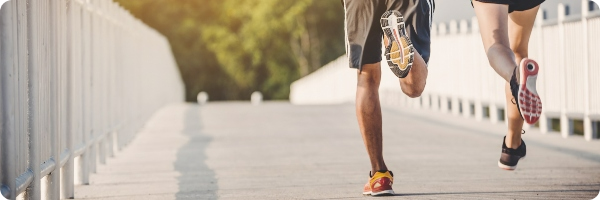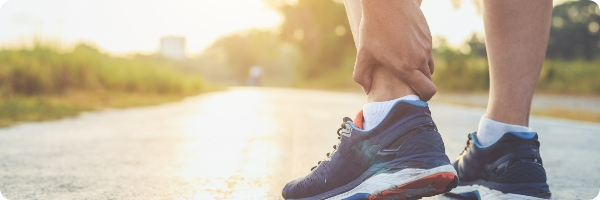Exercising regularly, combined with eating a balanced diet, plays a pivotal role in maintaining a healthy lifestyle. Not only is it beneficial to your physical health, any form of exercise – like running – encourages the production of endorphins, otherwise known as the “feel-good” transmitters in the brain.
Running is a great way to increase your cardiovascular fitness and, as it’s a weight bearing exercise, it helps to build strong bones, alongside strengthening muscles.
So, if you’re looking to get into running but you’ve never run before, this article will help you lace up those trainers and get started.
Start off slow
Introducing any new hobby takes work and practice, so avoid pushing yourself to your limits on your first run. Instead, start off slow and build up your endurance gradually – otherwise, you could find yourself injured. You may find it beneficial, and more tolerable, to make your first ‘run’ a brisk walk instead. Or you could combine running with walking, altering your speed every so often to give yourself time to recover – a technique that’s encouraged in the Couch to 5k programme.
Get a good quality pair of trainers
Investing in a good quality pair of trainers is essential for running. There are various types of trainers out there, and picking the perfect pair can be daunting – especially if you’ve never run before. The decision you make will depend on a variety of factors, including how much you’re willing to spend, what your running style is, the shape of your feet, and where you’re wanting to run.
There’s also the option of barefoot running – a style that’s increased in popularity over recent years due to the various benefits this may carry, such as reducing injury and strengthening your feet. Of course, there are also risks, and it probably isn’t the best method if you’re a beginner.

Have your running style assessed
A specialist, or having an assessment in a running shop, can help you find the right running shoes, because although they won’t help you run any faster, they can come with higher quality cushioning and be adjusted for your gait – which is the physical way you run. In doing this, they’ll be able to evaluate your current running style and see whether you have any muscle imbalances. For example, they can check for overpronation as your foot strikes the ground – which is where your foot rolls inwards as you move – or weak gluteal muscles – an incredibly common imbalance that can affect your running.
After performing the assessment, you’ll be advised on which trainers to opt for, alongside whether you’ll need to do any strengthening exercises to correct imbalances and reduce the possibility of injury.
Identifying muscle imbalances
It’s important to identify any muscle imbalances before you take up running as a hobby. This is because these can exacerbate injuries, as well as affect your body’s biomechanics and running style.
There are two main types of muscle imbalances:
- Body muscular imbalance – This is when the muscles on each side of your body aren’t symmetrical – in terms of both size and strength.
- Joint muscular imbalance – If one or more of the muscles that surround your joints becomes stronger, weaker, tighter or looser than normal, you may find that your joint movement is limited.
It’s possible to correct muscle imbalances with exercise, but this should be done with caution so you don’t do further damage. If you suspect that you have any muscle imbalances, and it’s interfering with your day-to-day life and running abilities, book an appointment with your doctor.
Running with a muscle imbalance
If you know you have a muscle imbalance, you should take the necessary steps to protect yourself on your run. For example, individuals with tight ITBs (iliotibial band – a thick band of tissue that runs down the length of the outside of your thigh) could use a foam roller – this can be used both for warming up and cooling down, and it helps to relax and stretch out your muscles, as well as working on myofascial release – the fascia wraps around your muscles.
Injuries
Injuries aren’t unusual. If you find yourself suffering from shin splints (which is a form of shin pain caused by exercise), you may benefit from dry needling – which can help reduce tightness, muscle tension, and trigger points surrounding the lower leg.
If your injury is as a result of running, take a look at your current technique to see whether anything could be optimised – for example, do your running shoes fit you properly? Whilst healing from any injury, it’s important to avoid overexerting yourself, which can lead to further injury. In the meantime, you could switch to a lighter form of exercise, such as yoga or swimming. Advice from an osteopath (who charge) of a physiotherapist (on the NHS), could help with longstanding pain.

Warm up and cool down
Before heading out on your run – or before engaging in any exercise, for that matter – you should always warm up. This prepares your body for intense physical activity, and decreases the risk of sustaining an injury.
Cooling down after your run – such as through gentle stretching – is just as important, as this helps to gradually bring your heart rate and blood pressure back down to normal.
Find what works best for you
Possibly the most important take away here is to find an exercise routine that works best for you, as everyone will have different running preferences. For most people, enjoying running means you’re more likely to continue and reap the benefits. If you struggle with motivation, you may prefer to go with a running buddy, or if a certain type of music gets you pumped, create a running playlist! Others may benefit from setting goals, which is one way to make the process more rewarding. Everyone will have a different routine in place, and you can create the environment that will make your run happen.
Exercising with a long-term condition
It’s still possible to exercise with some long-term conditions, however, it’s always best to check with your GP about what degree of exercise is safest. In fact, physical exercise may even benefit you, in some cases.
Did you know you can track body measurements and your fitness levels in the Evergreen Life app? You can also receive more personalised tips on how to improve other aspects of your wellbeing such as diet, sleep and happiness. Download the app below (if you haven’t already) and take the Fitness Check to start your wellness journey.
Reviewed by:
Anna Keeble – Head of Content
- Cleveland Clinic (2022) Overpronation. Cleveland Clinic.
- Cleveland Clinic (2022) The Benefits of Barefoot Running. Cleveland Clinic.
- Linden DJ (2021) The Truth Behind ‘Runner’s High’ and Other Mental Benefits of Running. John Hopkins Medicine.
- NHS UK (2019) Shin splints. NHS UK.
- Pinckard K, Baskin KK and Stanford KI (2019) Effects of Exercise to Improve Cardiovascular Health. Front Cardiovasc Med. 6: 69 (doi: 10.3389/fcvm.2019.00069).
- Williams J (2018) Dry Needling for Shin Splints. Access Health Chiropractic Center.





